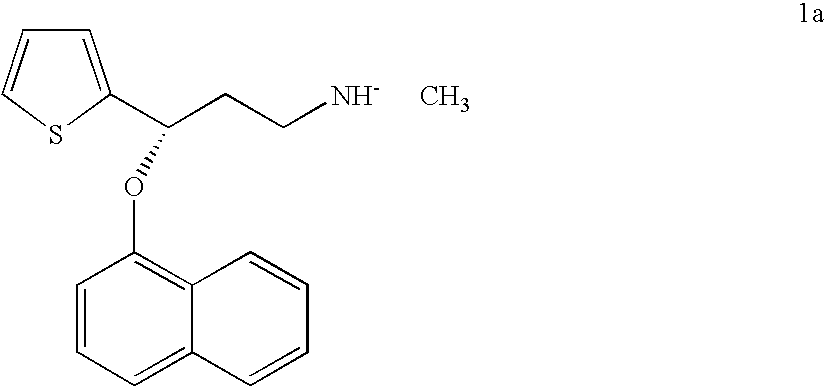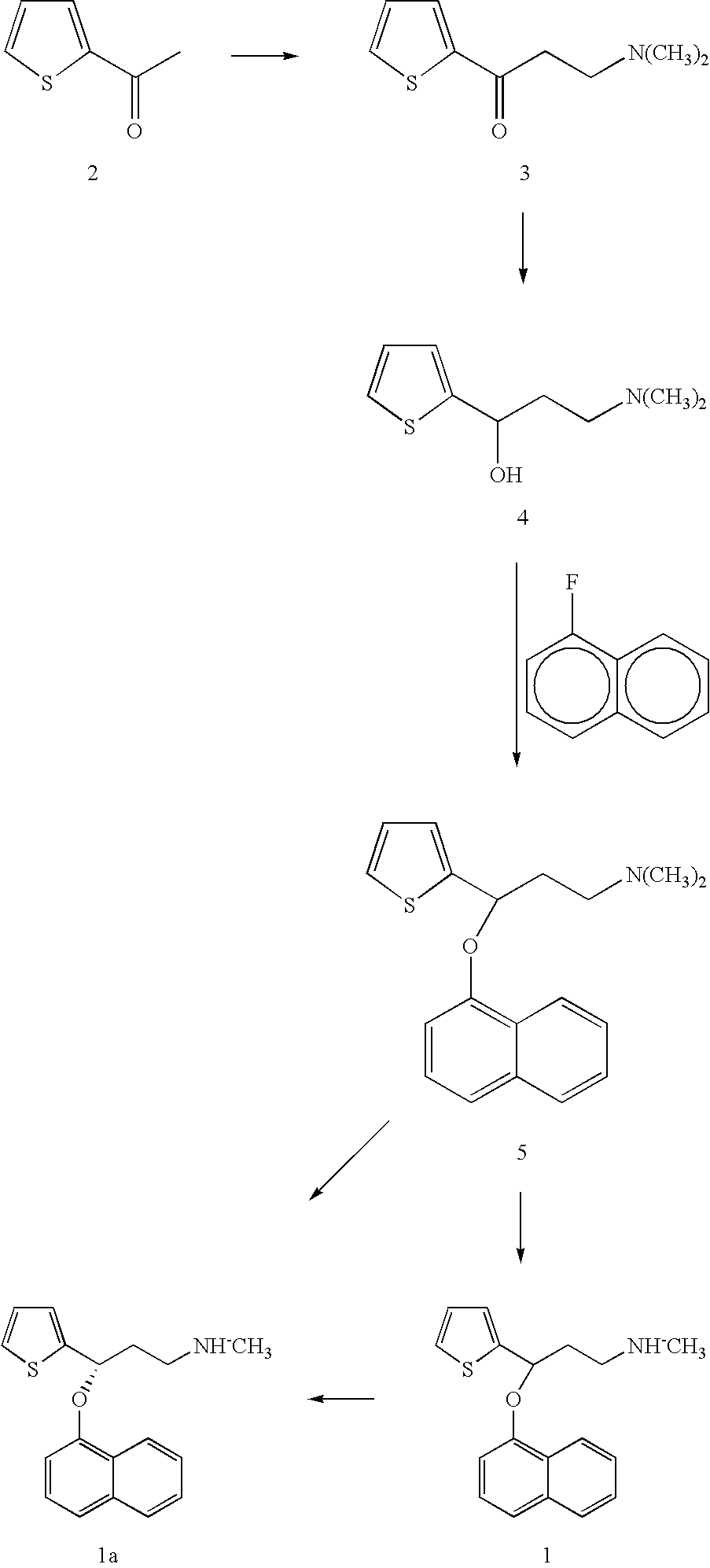Process for making duloxetine and related compounds
a technology of duloxetine and related compounds, applied in the field of making duloxetine and its related compounds, can solve the problems of low yield, unstable compound 6 of compound 6, and difficult preparation of compound 6 by mannich reaction
- Summary
- Abstract
- Description
- Claims
- Application Information
AI Technical Summary
Problems solved by technology
Method used
Image
Examples
example 1
Preparation of the Compound 10
[0045]A 50 ml bottle equipped with a reflux condenser, stirrer, nitrogen inlet tube was charged with 8.0 g of 2-acetylthiophene, 10 ml of ethanol, 7.5 g of N-methylhydroxylamine hydrochloride, 2.5 g of paraformaldehyde and 0.05 ml of 36% hydrochloric acid. The mixture was heated at reflux. All solid dissolved and after 3 hours the reaction mixture was diluted with 10 ml of ethanol, cooled in a refrigerator and mixed with 70 ml of acetone. The mixture was stirred for 30 min., solid was filtered off, the cake was washed with acetone and air dried to give 10.35 g of 10 hydrochloride.
[0046]5.1 g of 10 hydrochloride was dissolved in 10 ml of water and solution of 3.15 g of potassium carbonate in 10 ml of water was added. White crystals precipitated, they were filtered and the cake washed with water and air dried to give 3.7 g of 10 with HPLC purity 99.1% rel.
[0047]NMR confirmed the structure.
example 2
Preparation of the Racemic Compound 11
[0048]3.8 g of compound 10 was dissolved in 200 ml of ethanol, 0.74 g of sodium borohydride dissolved in 4 mL of alkalinized water was added and the mixture was stirred at ambient temperature for 16 h. Then 8 mL of acetone was added, mixture was stirred for 1 h and 20 mL of water was added. The mixture was twice extracted with 20 mL of ethylacetate. The combined ethylacetate extracts were washed with brine and concentrated in vacuo. Crystals precipitated on cooling, they were filtered off and air dried to give 2.5 g of a yellow solid product of the formula 11.
example 3
Preparation of the Compound 7
[0049]0.47 g of the compound 11 was dissolved in 6 ml of a mixture of glacial acetic acid and water (1:1 v / v) to form a slight yellow solution. Then 0.39 g of zinc was added and the reaction mixture was stirred at 50C for 1 hour. Reaction mixture was cooled to ambient temperature, alkalinized with a 15% aqueous NaOH solution and evaporated to dryness. The solid was extracted with 20 ml of toluene. Combined toluene extracts were concentrated in vacuo, the residue dissolved in 3 ml of isopropanol and a solution of 0.22 g of oxalic acid in 1 ml isopropanol was added. The formed precipitate was filtered, the cake was washed with isopropanol and dried on air to give 0.39 g of the compound of formula 7, as oxalate.
PUM
| Property | Measurement | Unit |
|---|---|---|
| enantiomers | aaaaa | aaaaa |
| chirality | aaaaa | aaaaa |
| purity | aaaaa | aaaaa |
Abstract
Description
Claims
Application Information
 Login to View More
Login to View More - R&D
- Intellectual Property
- Life Sciences
- Materials
- Tech Scout
- Unparalleled Data Quality
- Higher Quality Content
- 60% Fewer Hallucinations
Browse by: Latest US Patents, China's latest patents, Technical Efficacy Thesaurus, Application Domain, Technology Topic, Popular Technical Reports.
© 2025 PatSnap. All rights reserved.Legal|Privacy policy|Modern Slavery Act Transparency Statement|Sitemap|About US| Contact US: help@patsnap.com



